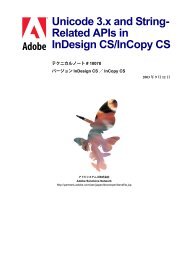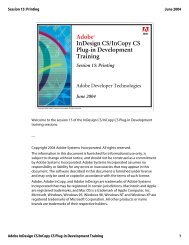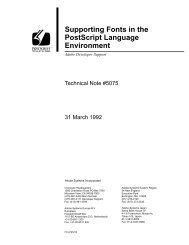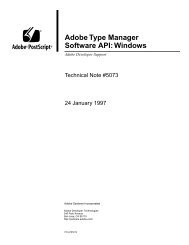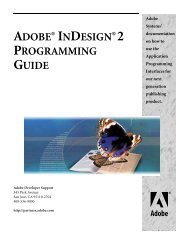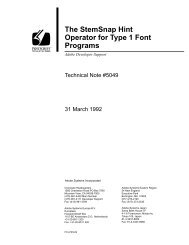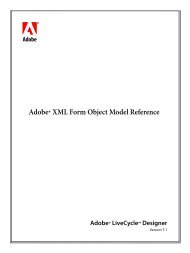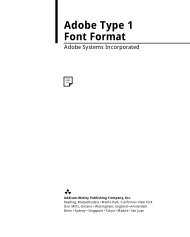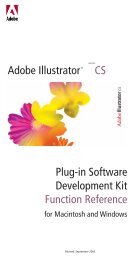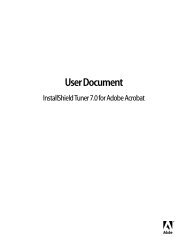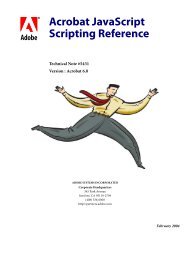Update to PPD Specification Version 4.3 #5645 - Adobe Partners
Update to PPD Specification Version 4.3 #5645 - Adobe Partners
Update to PPD Specification Version 4.3 #5645 - Adobe Partners
Create successful ePaper yourself
Turn your PDF publications into a flip-book with our unique Google optimized e-Paper software.
Contents1 Introduction 52 *FastImage 63 Resource Entries 7*Resource 7*categoryNameInstance 8*Resource and *categoryNameInstance combinations 94 *GuaranteedMaxSeparations 95 *NonUIConstraints 106 *Font 10iii
iv Contents 29 Apr 97
The new optional *GuaranteedMaxSeparations entry is associated with theMaxSeparations page device parameter, introduced in PostScript languageversion 3010. This will be recognized by a future release of <strong>Adobe</strong>PageMaker.2 *FastImage*FastImage modeOption: "invocation"UI*DefaultFastImage: modeOption*?FastImage: "query"*FastImage is similar <strong>to</strong> *OutputMode except that it is specifically for thefast image processing feature introduced in PostScript language version3010, and controlled by the new Half<strong>to</strong>neMode user parameter. This featuremust be thoroughly unders<strong>to</strong>od for a particular product before that product’s*FastImage entry is written.This feature is only applicable <strong>to</strong> monochrome products; the fast imagekeywords should be omitted on products incapable of a monochrome-onlymode. OEMs with products capable of both monochrome and color modesmay want <strong>to</strong> constrain the *FastImage choices according <strong>to</strong> *ColorModelchoices, via *UIConstraints.The currently valid modeOptions are:• None or False—No fast image processing will be done by either the hos<strong>to</strong>r the product.• 1 or True—The host may optionally produce images optimized for speedwith insignificant loss of quality. The product may override any requests <strong>to</strong>change the half<strong>to</strong>ne, and may process images using the <strong>Adobe</strong> fast imagefeature (Half<strong>to</strong>neMode) with no significant loss of quality.• 2—The host behaves the same as for modeOption 1. The product behavesthe same except that it should process images faster with a possible minorloss of quality, on average.The following is sample code for the PickOne variant:*OpenUI *FastImage/Showing Images: PickOne*DefaultFastImage: None*OrderDependency: 90 AnySetup *FastImage*FastImage None/Document Settings: " setuserparamscurrenthalf<strong>to</strong>ne sethalf<strong>to</strong>ne"*End6 <strong>Update</strong> <strong>to</strong> <strong>PPD</strong> <strong>Specification</strong> <strong>Version</strong> <strong>4.3</strong> 29 Apr 97
*FastImage 1/Optimized for Quality: " setuserparamscurrenthalf<strong>to</strong>ne sethalf<strong>to</strong>ne"*End*FastImage 2/Optimized for Performance: " setuserparamscurrenthalf<strong>to</strong>ne sethalf<strong>to</strong>ne"*End*?FastImage: "currentuserparams /Half<strong>to</strong>neMode get get = flush"*End*CloseUI: *FastImageThe value for *DefaultFastImage should reflect the value of theHalf<strong>to</strong>neMode user parameter when the product is first initialized.If output from Half<strong>to</strong>neMode 2 is not supported or if the OEM wishes <strong>to</strong> hideit from the user, but Half<strong>to</strong>neModes 0 and 1 are supported then a Boolean*OpenUI style may be best, with an *OpenUI translation string such as“Faster, uniform images?”.A product is entitled <strong>to</strong> have Half<strong>to</strong>neMode 1 mean that a product-specifichalf<strong>to</strong>ne is imposed on the job. If such a product also allows Half<strong>to</strong>neMode 0and 2 then the above sample code would typically be used.If a product has Half<strong>to</strong>neMode 1 mean that a product-specific half<strong>to</strong>ne isimposed on the job, and Half<strong>to</strong>neMode 0 is supported but Half<strong>to</strong>neMode 2 isnot, then another UI entry such as *OutputMode should be used.<strong>Adobe</strong>’s Windows ® 95 printer driver <strong>Adobe</strong>PS 4.2 and <strong>Adobe</strong>’s Macin<strong>to</strong>sh ®printer driver <strong>Adobe</strong>PS 8.5 recognize the *FastImage keyword and optimizefor speed with insignificant loss of quality for modeOptions 1 and 2.3 Resource EntriesThe fact that certain resources exist within a product may be specified withthe *Resource and *categoryNameInstance keywords.These keywords are optional. Omitting these keywords says nothing aboutwhether unmentioned PostScript language resource categories or instancesexist.3.1 *Resource*Resource categoryName: Implicit | Regular | Virtual3 Resource Entries 7
This entry declares that the categoryName resource category applies <strong>to</strong> thisproduct and that the <strong>PPD</strong> file may also contain *categoryNameInstancekeyword(s). For example, if categoryName were TrappingType then*TrappingTypeInstance keywords may follow.The currently defined values for *Resource are:• Regular—The product has the regular resource category namedcategoryName. The PostScript opera<strong>to</strong>r findresource is meaningful forthis category.• Implicit—The product has an implicit resource category namedcategoryName. The PostScript opera<strong>to</strong>r findresource is not meaningfulfor this category; resourceforall and resourcestatus are. Implicitresource instance names or numbers represent some built-in capability ofthe product.• Virtual—The product does not have a resource category namedcategoryName. Virtual resource instance names or numbers representsome built-in capability of the product that is not otherwise convenientlyrepresentable.*Resource may not appear within *OpenUI and *CloseUI.The absence of a particular *Resource entry says nothing about the existenceof that category on the product. Features reflected in existing <strong>PPD</strong> file entries,such as *Font, should continue <strong>to</strong> use those <strong>PPD</strong> file entries.3.2 *categoryNameInstance*categoryNameInstance instanceName: “...”This means that categoryName has been declared in a *Resource entry andthat instanceName is the name of an instance for this category. Because theresource may be Virtual, the category and instance may not be visible from aPostScript job.NoteinstanceName is restricted <strong>to</strong> the syntax for <strong>PPD</strong> option keywords. Thismeans that instanceName may not contain special characters, even thoughthey are legal in a PostScript program.The meaning of “...” is undefined. Parsers should accept a normalInvocationValue here, but its use is undefined. <strong>PPD</strong> files should supply anempty InvocationValue, “”, <strong>to</strong> avoid undefined effects. A future version of the<strong>PPD</strong> File Format <strong>Specification</strong> may define a meaning.8 <strong>Update</strong> <strong>to</strong> <strong>PPD</strong> <strong>Specification</strong> <strong>Version</strong> <strong>4.3</strong> 29 Apr 97
The absence of a particular entry says nothing about the existence of thecategoryName category or its instance named instanceName. Featuresreflected in existing <strong>PPD</strong> file entries, such as *Font, should continue <strong>to</strong> usethose <strong>PPD</strong> entries.CommentThis style was chosen over more compact representations because many <strong>PPD</strong>parsers already recognize this style.3.3 *Resource and *categoryNameInstance combinationsThe following combination is unders<strong>to</strong>od by certain plug-ins. Thiscombination should be included in <strong>PPD</strong> files that may be used with suchplug-ins.3.3.1 TrappingTypeThe entries below indicate that the product supports in-RIP trapping asdefined in the Supplements for PostScript language versions 2017 and later.Subsequent products may have Implicit category TrappingType with severalinstance numbers. These particular <strong>PPD</strong> file entries are recognized by certainplug-ins that will be available in 1997.*Resource TrappingType: Virtual*TrappingTypeInstance 1001: ""4 *GuaranteedMaxSeparations*GuaranteedMaxSeparations number: "..."*DefaultGuaranteedMaxSeparations:*?GuaranteedMaxSeparations:number"query"This entry indicates the maximum number of selectable separations that areguaranteed <strong>to</strong> be supported on all configurations. In other words, this is thesmallest value of the MaxSeparations page device parameter among allavailable configurations. *NonUIConstraints may be used <strong>to</strong> affect theapplicable value.Several *GuaranteedMaxSeparations keywords may be supplied. Some ofthese choices may be unavailable due <strong>to</strong> the effect of *NonUIConstraintsentries. The largest number from the available choices indicates themaximum number of selectable separations that are guaranteed <strong>to</strong> besupported in available configurations.For example, a product may support MaxSeparations of 3 for allconfigurations except duplex or 11x17 paper, when it supports only 1. Thefollowing example illustrates this situation.4 *GuaranteedMaxSeparations 9
*DefaultGuaranteedMaxSeparations: 3*GuaranteedMaxSeparations 3: ""*GuaranteedMaxSeparations 1: ""*?GuaranteedMaxSeparations: "currentpagedevice /MaxSeparations get ="*End*NonUIConstraints: *Duplex DuplexTumble *GuaranteedMaxSeparations 3*NonUIConstraints: *GuaranteedMaxSeparations 3 *Duplex DuplexTumble*NonUIConstraints: *Duplex DuplexNoTumble *GuaranteedMaxSeparations3*NonUIConstraints: *GuaranteedMaxSeparations 3 *DuplexDuplexNoTumble*NonUIConstraints: *PageSize Tabloid *GuaranteedMaxSeparations 3*NonUIConstraints: *GuaranteedMaxSeparations 3 *PageSize Tabloid*NonUIConstraints: *PageRegion Tabloid *GuaranteedMaxSeparations 3*NonUIConstraints: *GuaranteedMaxSeparations 3 *PageRegion TabloidIf only one value for *GuaranteedMaxSeparations is applicable for aproduct, then only *DefaultGuaranteedMaxSeparations may be supplied.Here is an example.*DefaultGuaranteedMaxSeparations: 2If this entry is omitted for a product compliant with PostScript languageversion 3010 or later a *DefaultGuaranteedMaxSeparations value of 1 isimplied. If this entry is omitted for a product compliant with PostScriptlanguage version 2017 or prior, a value of 0 is implied.This entry uses the UI style solely <strong>to</strong> take advantage of *NonUIConstraintsentries. Since this entry does not indicate a user selectable feature, it shouldnot appear between *OpenUI and *CloseUI.The meaning of "..." is undefined. Parsers should accept a normalInvocationValue here, but its use is undefined. <strong>PPD</strong> files should supply anempty InvocationValue, "", <strong>to</strong> avoid undefined effects. A future version of the<strong>PPD</strong> File Format <strong>Specification</strong> may define a meaning.5 *NonUIConstraintsThe *NonUIConstraints keyword has been extended so it may be used with*GuaranteedMaxSeparations.6 *FontThe *Font keyword has been extended <strong>to</strong> allow a new encoding name and anew charset name. This allows use of fonts designed <strong>to</strong> work with CentralEuropean alphabets. The <strong>Adobe</strong>PS 4.2 driver understands these.10 <strong>Update</strong> <strong>to</strong> <strong>PPD</strong> <strong>Specification</strong> <strong>Version</strong> <strong>4.3</strong> 29 Apr 97
Win1250 may be specified as encoding. This corresponds <strong>to</strong> “code page1250” described on pages 453-459 of Developing International Software forWindows 95 and Windows NT, by Nadine Kano, Microsoft Press, © 1995,ISBN 1-55615-940-8.ExtendedRoman may be specified as charset. This is the combination of:• Standard charset• the characters mentioned in the Win1250 encoding• certain other charactersThe precise definition of ExtendedRoman is in the Supplement: PostScriptLanguage Reference Manual, For <strong>Version</strong> 3010.6 *Font 11
12 <strong>Update</strong> <strong>to</strong> <strong>PPD</strong> <strong>Specification</strong> <strong>Version</strong> <strong>4.3</strong> 29 Apr 97





